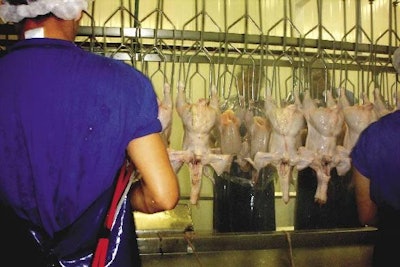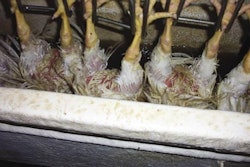
I would like to share some reflections on factors that affect giblet quality and yield, beginning with feed withdrawal and continuing throughout processing.
Feed withdrawal
Feed withdrawal is an almost universal practice in order to ensure that the intestinal tract of the chicken, which is the final part of the digestive system, is as clean as possible to prevent contamination problems during evisceration. The usual period of 8-12 hours prior to slaughter may not always be sufficient.
Transportation and storage
Chicken tend naturally to lie down once they have been placed into the transport crate. This prevents normal movement and digestion of any feed recently consumed because the crop, proventriculus and gizzard are partially constricted against the crate floor. Consequently, during evisceration, undigested feed goes directly to waste, representing a financial loss. This loss becomes significant if there is a large amount of undigested feed, or if the feed contaminates the proventriculus and gizzard (especially when sold with fat) to such an extent that cleaning is impossible and the material has to be rejected. This decision can reduce the final yield of the process.
Extending the feed withdrawal period
This problem is very marked in plants which, due to particular logistical circumstances, must transport the birds to the processing plant at short notice. Some of the organs are especially affected by extending the feed withdrawal period to 13 hours or more. The liver, for example, becomes smaller and darker. On the other hand, the gizzard's interior yellow cuticle becomes harder, which forces the worker to put more pressure on this organ against the peeler rollers, removing some additional meat that could have been sold. Again, this represents a loss of yield.
Processing
During evisceration, the internal organs that are destined for human consumption are separated from those that are sent to the rendering plant. Often I observe with frustration that large quantities of giblets have dropped onto the evisceration trough, floor, drain channels, platform, etc. It is too late for these materials as they are already contaminated but too often, no attempt has been made to prevent this waste. This apathetic behaviour of the administrative and operational personnel is hard to understand when we remember that approximately five complete giblets sets are equivalent to one processed carcass.
Possible causes include equipment deficiencies, poor ergonomic conditions, attitude problems of the line personnel and lack of knowledge about the special characteristics of these products. It is worthwhile taking some time to rectify these problems.
Chilling
The main function of chilling is the control of bacterial growth. The livers and hearts, especially in plants that do not have automatic dispatches to the respective chillers, are usually placed in tanks that are located next to the workers carrying out the separation at the evisceration line.
Even when held in these tanks for a short period, the delicate products are subjected to a heat concentration. The average temperature of around 40°C favours the logarithmic multiplication of micro-organisms every 15 minutes. It is common for the tanks to be moved to the chillers in batches. The quality of these products can be greatly improved by adding ice to the giblets container a simple, cheap and easy way to preserve quality.
In some poultry plants, the necks are also stored in a similar way. They are washed before being sent to the chiller in order to prevent blood from turning the water in the container red.
Another critical aspect of this phase that receives little attention is to ensure that all the various organs and other parts are maintained totally submerged in the water-and-ice mixture in the chiller or cooling tub. It is not unusual to observe piles of the product above the water level of the containers. This negligent management has deleterious effects on quality, yield and shelf life. The water should be maintained as near as possible to freezing point. Where permitted, a bactericide can be used. Sufficient water should be added on average, one litre for each 10 carcasses. In a plant processing 1000 birds/hour, this means that 100 litres of water should be added to the giblets chillers each hour.
Packaging
After 15-30 minutes, the giblets automatically leave the chillers and they are placed on large table where the workers check their quality and pack them in plastic bags. The contents of each pack depend on the market, and may include the organs of just one chicken or in bulk, either mixed or separate. Too often, the trays are overfilled with bags, leading to compression of the contents, deterioration in presentation and a reduction in yield. Ideally, the organs should have an average temperature of 2°C when they leave the chiller and less than 4°C when they enter the cold rooms.
Storage rooms
For reasons that I do not understand and find hard to accept, giblet trays are quite often stored near to the evaporators. Because of the recirculation of air, this is the warmest area of the room inappropriate for products that are delicate in nature and have a high fat content. It contributes towards the rapid oxidation of the fat and a stale smell. Giblets particularly should be stored under cool conditions.
Take care when handling and processing giblets
This article would have been longer if I had listed all the irregular mistakes I have observed in the handling of these organs. In many markets, the giblets achieve high prices because they are destined to be consumed as snacks or small meals, and in the case of the gizzards, the daily demand is not satisfied.
The aim is to call the attention of the processors to the fact that the giblets account for 15% of liveweight, and need to be taken into account when calculating the losses of the process: the loss of weight between the live chicken and the processed carcass including the giblets. With the proper attention, moisture uptake and retention by carcasses can be regulated to achieve a total average loss of the process without injection before entering the cold rooms of 6% in countries where there it is established that the water uptake in the chillers at the time of the packaging should not exceed 12%.
Table 1 shows that the giblets account for 15% of the weight of a 2-kg broiler or 300g. This fact is often overlooked by processing plant managers when the offal is mixed together and the various elements are not individually recorded for operational reasons. These few grammes seen independently seem insignificant to some processing plant managers but proper handling and storage of these materials can positively impact the bottom line, and optimise the return on the investment in the whole production chain.




.jpg?auto=format%2Ccompress&fit=crop&h=167&q=70&w=250)












